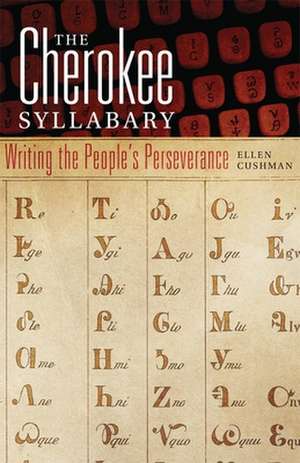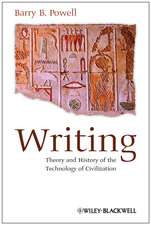The Cherokee Syllabary: Writing the People's Perseverance: American Indian Literature & Critical Studies (Paperback), cartea 56
Autor Ellen Cushmanen Limba Engleză Paperback – 18 mar 2013
Vezi toate premiile Carte premiată
In 1821, Sequoyah, a Cherokee metalworker and inventor, introduced a writing system that he had been developing for more than a decade. His creation the Cherokee syllabary helped his people learn to read and write within five years and became a principal part of their identity. This groundbreaking study traces the creation, dissemination, and evolution of Sequoyah s syllabary from script to print to digital forms. Breaking with conventional understanding, author Ellen Cushman shows that the syllabary was not based on alphabetic writing, as is often thought, but rather on Cherokee syllables and, more importantly, on Cherokee meanings.
Employing an engaging narrative approach, Cushman relates how Sequoyah created the syllabary apart from Western alphabetic models. But he called it an alphabet because he anticipated the Western assumption that only alphabetic writing is legitimate. Calling the syllabary an alphabet, though, has led to our current misunderstanding of just what it is and of the genius behind it until now.
In her opening chapters, Cushman traces the history of Sequoyah s invention and explains the logic of the syllabary s structure and the graphic relationships among the characters, both of which might have made the system easy for native speakers to use. Later chapters address the syllabary s enduring significance, showing how it allowed Cherokees to protect, enact, and codify their knowledge and to weave non-Cherokee concepts into their language and life. The result was their enhanced ability to adapt to social change on and in Cherokee terms.
Cushman adeptly explains complex linguistic concepts in an accessible style, even as she displays impressive understanding of interrelated issues in Native American studies, colonial studies, cultural anthropology, linguistics, rhetoric, and literacy studies. Profound, like the invention it explores, "The Cherokee Syllabary" will reshape the study of Cherokee history and culture.
"Published through the Recovering Languages and Literacies of the Americas initiative, supported by the Andrew W. Mellon Foundation""
| Toate formatele și edițiile | Preț | Express |
|---|---|---|
| Paperback (1) | 188.70 lei 6-8 săpt. | |
| University of Oklahoma Press – 18 mar 2013 | 188.70 lei 6-8 săpt. | |
| Hardback (1) | 265.35 lei 6-8 săpt. | |
| University of Oklahoma Press – 30 noi 2011 | 265.35 lei 6-8 săpt. |
Din seria American Indian Literature & Critical Studies (Paperback)
-
 Preț: 165.96 lei
Preț: 165.96 lei -
 Preț: 127.59 lei
Preț: 127.59 lei -
 Preț: 134.95 lei
Preț: 134.95 lei -
 Preț: 89.11 lei
Preț: 89.11 lei -
 Preț: 111.90 lei
Preț: 111.90 lei -
 Preț: 188.90 lei
Preț: 188.90 lei -
 Preț: 147.71 lei
Preț: 147.71 lei -
 Preț: 170.93 lei
Preț: 170.93 lei -
 Preț: 171.13 lei
Preț: 171.13 lei -
 Preț: 169.46 lei
Preț: 169.46 lei -
 Preț: 116.13 lei
Preț: 116.13 lei -
 Preț: 169.09 lei
Preț: 169.09 lei -
 Preț: 169.46 lei
Preț: 169.46 lei -
 Preț: 99.19 lei
Preț: 99.19 lei -
 Preț: 151.22 lei
Preț: 151.22 lei -
 Preț: 193.87 lei
Preț: 193.87 lei -
 Preț: 233.60 lei
Preț: 233.60 lei -
 Preț: 163.91 lei
Preț: 163.91 lei -
 Preț: 151.05 lei
Preț: 151.05 lei
Preț: 188.70 lei
Nou
33.40€ • 39.17$ • 29.28£
Carte tipărită la comandă
Livrare economică 27 ianuarie-10 februarie 26
Specificații
ISBN-10: 0806143738
Pagini: 238
Dimensiuni: 140 x 210 x 14 mm
Greutate: 0.29 kg
Editura: University of Oklahoma Press
Seria American Indian Literature & Critical Studies (Paperback)
Notă biografică
Descriere
In 1821, Sequoyah, a Cherokee metalworker and inventor, introduced a writing system that he had been developing for more than a decade. His creation--the Cherokee syllabary--helped his people learn to read and write within five years and became a principal part of their identity. This groundbreaking study traces the creation, dissemination, and evolution of Sequoyah's syllabary from script to print to digital forms. Breaking with conventional understanding, author Ellen Cushman shows that the syllabary was not based on alphabetic writing, as is often thought, but rather on Cherokee syllables and, more importantly, on Cherokee meanings. Employing an engaging narrative approach, Cushman relates how Sequoyah created the syllabary apart from Western alphabetic models. But he called it an alphabet because he anticipated the Western assumption that only alphabetic writing is legitimate. Calling the syllabary an alphabet, though, has led to our current misunderstanding of just what it is and of the genius behind it--until now. In her opening chapters, Cushman traces the history of Sequoyah's invention and explains the logic of the syllabary's structure and the graphic relationships among the characters, both of which might have made the system easy for native speakers to use. Later chapters address the syllabary's enduring significance, showing how it allowed Cherokees to protect, enact, and codify their knowledge and to weave non-Cherokee concepts into their language and life. The result was their enhanced ability to adapt to social change on and in Cherokee terms. Cushman adeptly explains complex linguistic concepts in an accessible style, even as she displays impressive understanding of interrelated issues in Native American studies, colonial studies, cultural anthropology, linguistics, rhetoric, and literacy studies. Profound, like the invention it explores, "The Cherokee Syllabary" will reshape the study of Cherokee history and culture.
"
Published through the Recovering Languages and Literacies of the Americas initiative, supported by the Andrew W. Mellon Foundation"
Recenzii
Premii
- Oklahoma Book Award Finalist, 2012





